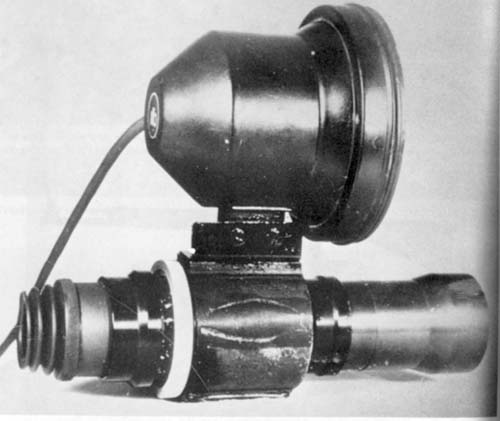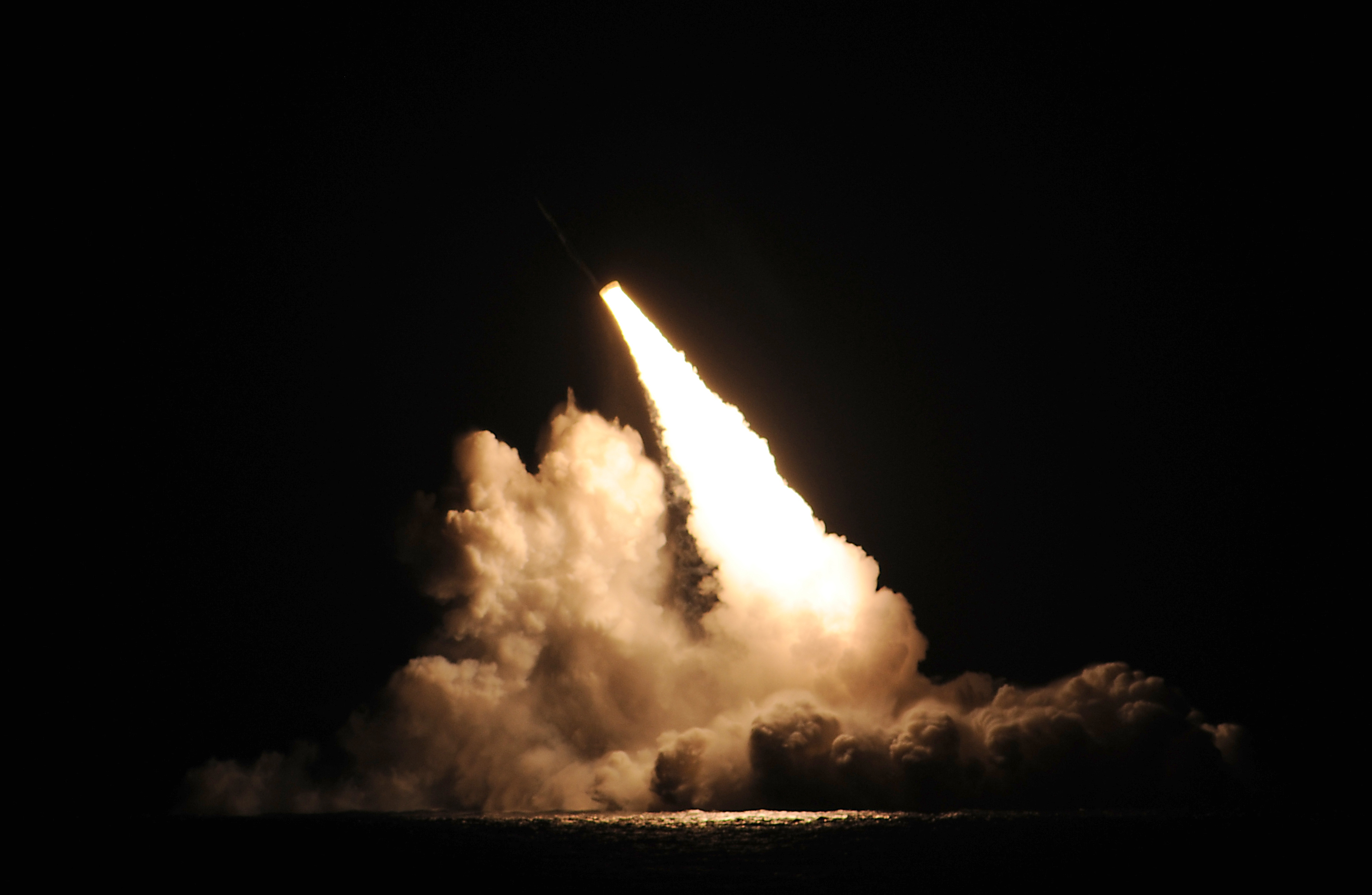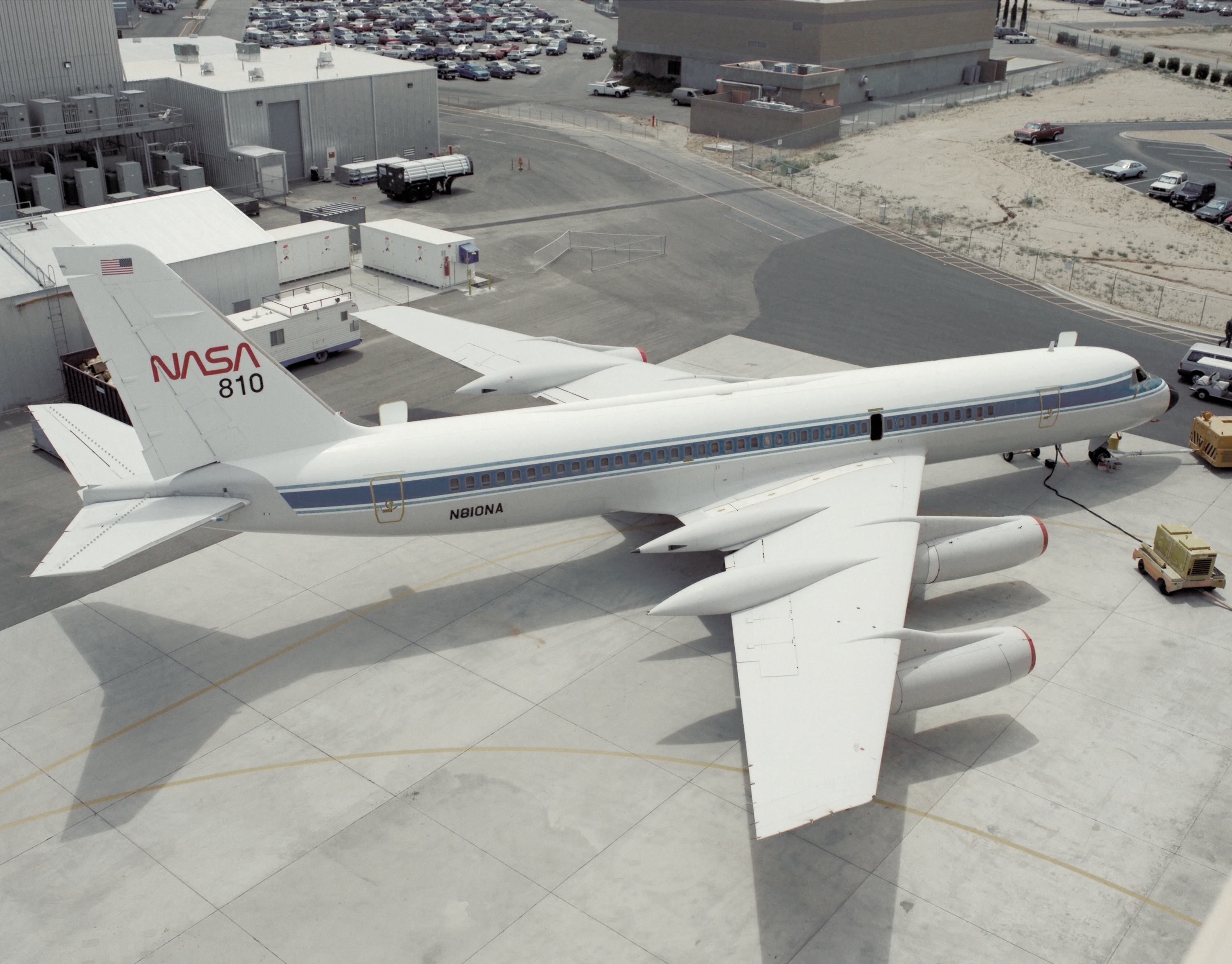|
Drag-reducing Aerospike
A drag-reducing aerospike is a device (see nose cone design) used to reduce the forebody pressure aerodynamic drag of blunt bodies at supersonic speeds. The aerospike creates a detached shock ahead of the body. Between the shock and the forebody a zone of recirculating flow occurs which acts like a more streamlined forebody profile, reducing the drag. Development This concept was used on the UGM-96 Trident I and is estimated to have increased the range by 550 km. The Trident aerospike consists of a flat circular plate mounted on an extensible boom which is deployed shortly after the missile breaks through the surface of the water after launch from the submarine. The use of the aerospike allowed a much blunter nose shape, providing increased internal volume for payload and propulsion without increasing the drag. This was required because the Trident I C-4 was fitted with a third propulsion stage to achieve the desired increase in range over the UGM-73 Poseidon, Poseidon C-3 ... [...More Info...] [...Related Items...] OR: [Wikipedia] [Google] [Baidu] |
Aerospike Detail
Aerospike may refer to: * Aerospike engine, a rocket engine without a traditional rocket nozzle * Drag-reducing aerospike, a device which reduces drag on missiles by creating a detached shock above the missile * Components of jet engines, Aerospike cone, a jet engine exhaust cone * Aerospike (database), an open-source noSQL database ** Aerospike (company), a technology company based in Mountain View, California, US {{disambiguation ... [...More Info...] [...Related Items...] OR: [Wikipedia] [Google] [Baidu] |
Infrared Homing
Infrared homing is a Missile guidance#Passive homing, passive weapon guidance system which uses the infrared (IR) light emission from a target to track and follow it seamlessly. Missiles which use infrared seeking are often referred to as "heat-seekers" since infrared is radiated strongly by hot bodies. Many objects such as people, vehicle engines and aircraft generate and emit heat and so are especially visible in the infrared wavelengths of light compared to objects in the background. Infrared seekers are passive devices, which, unlike radar, provide no indication that they are tracking a target. That makes them suitable for sneak attacks during visual encounters or over longer ranges when they are used with a forward looking infrared or similar cueing system. Heat-seekers are extremely effective: 90% of all timeline of United States military operations, United States air combat losses between 1984 and 2009 were caused by infrared-homing missiles. They are, however, subject ... [...More Info...] [...Related Items...] OR: [Wikipedia] [Google] [Baidu] |
Progress In Flight Physics
Progress is movement towards a perceived refined, improved, or otherwise desired state. It is central to the philosophy of progressivism, which interprets progress as the set of advancements in technology, science, and social organization efficiency – the latter being generally achieved through direct societal action, as in social enterprise or through activism, but being also attainable through natural sociocultural evolution – that progressivism holds all human societies should strive towards. The concept of progress was introduced in the early-19th-century social theories, especially social evolution as described by Auguste Comte and Herbert Spencer. It was present in the Enlightenment's philosophies of history. As a goal, social progress has been advocated by varying realms of political ideologies with different theories on how it is to be achieved. Measuring progress Specific indicators for measuring progress can range from economic data, technical innovations, chang ... [...More Info...] [...Related Items...] OR: [Wikipedia] [Google] [Baidu] |
National Aeronautics And Space Administration
The National Aeronautics and Space Administration (NASA ) is an independent agency of the US federal government responsible for the United States's civil space program, aeronautics research and space research. Established in 1958, it succeeded the National Advisory Committee for Aeronautics (NACA) to give the American space development effort a distinct civilian orientation, emphasizing peaceful applications in space science. It has since led most of America's space exploration programs, including Project Mercury, Project Gemini, the 1968–1972 Apollo program missions, the Skylab space station, and the Space Shuttle. Currently, NASA supports the International Space Station (ISS) along with the Commercial Crew Program and oversees the development of the Orion spacecraft and the Space Launch System for the lunar Artemis program. NASA's science division is focused on better understanding Earth through the Earth Observing System; advancing heliophysics through the effor ... [...More Info...] [...Related Items...] OR: [Wikipedia] [Google] [Baidu] |
American Institute Of Aeronautics And Astronautics
The American Institute of Aeronautics and Astronautics (AIAA) is a professional society for the field of aerospace engineering Aerospace engineering is the primary field of engineering concerned with the development of aircraft and spacecraft. It has two major and overlapping branches: aeronautical engineering and astronautical engineering. Avionics engineering is s .... The AIAA is the U.S. representative on the International Astronautical Federation and the International Council of the Aeronautical Sciences. In 2015, it had more than 30,000 members among aerospace professionals worldwide (a majority are American or live in the United States). History The AIAA was founded in 1963 from the merger of two earlier societies: the American Rocket Society (ARS), founded in 1930 as the American Interplanetary Society (AIS), and the Institute of the Aerospace Sciences (IAS), founded in 1932 as the Institute of the Aeronautical Sciences. Paul Johnston was the first executive ... [...More Info...] [...Related Items...] OR: [Wikipedia] [Google] [Baidu] |
Index Of Aviation Articles
Aviation is the design, development, production, operation, and use of aircraft, especially heavier-than-air aircraft. Articles related to aviation include: A Aviation accidents and incidents – Above Mean Sea Level (AMSL) – ADF – Accessory drive – Advance airfield – Advanced air mobility – Advanced technology engine – Adverse yaw – Aerial ramming – Aerial reconnaissance – Aerobatics – Aerodrome – Aerodrome mapping database (AMDB) – Aerodynamics – Aerofoil – Aerodrome beacon – Aeronautical Information Manual (AIM) – Aeronautical chart – Aeronautical Message Handling System – Aeronautical phraseology – Aeronautics – Aeronaval – Aerospace – Aerospace engineering – Afterburner – Agile Combat Employment (ACE) – Aileron – Air charter – Air defense identification zone (ADIZ) – Air freight terminal – Air traffic flow management – Air-augmented rocket – Airband – Airbase (AFB) – Airborne colli ... [...More Info...] [...Related Items...] OR: [Wikipedia] [Google] [Baidu] |
M51 (missile)
The M51 SLBM is a French submarine-launched ballistic missile, built by ArianeGroup, and deployed with the French Navy. Designed to replace the M45 (missile), M45 SLBM (in French terminology the MSBS – ''Mer-Sol-Balistique-Stratégique'' "Sea-ground-Strategic ballistic"), it was first deployed in 2010. Each missile carries six to ten Multiple independently targetable reentry vehicle, independently targetable TN 75 thermonuclear warheads. The three-stage engine of the M51 is directly derived from the solid propellant boosters of Ariane 5. Like other blunt-nosed SLBM examples, such as the Trident D5, the M51 uses an drag-reducing aerospike, extensible aerospike in the nose. The missiles are a compromise over the M5 SLBM design, which was to have a range of and carry ten new-generation ''tête nucléaire océanique'' ("oceanic nuclear warhead") MIRVs. Design work on the M5 started in the late 1980s by Aérospatiale, before the programme was renamed the M51 in 1996, when developme ... [...More Info...] [...Related Items...] OR: [Wikipedia] [Google] [Baidu] |
UGM-133 Trident II
The UGM-133A Trident II, or Trident D5 is a submarine-launched ballistic missile (SLBM), built by Lockheed Martin Space in Sunnyvale, California, and deployed with the United States Navy and Royal Navy. It was first deployed in March 1990, and remains in service. The Trident II Strategic Weapons System is an improved SLBM with greater accuracy, payload, and range than the earlier Trident C-4. It is a key element of the U.S. strategic nuclear triad and strengthens U.S. strategic deterrence. The Trident II is considered to be a durable sea-based system capable of engaging many targets. It has payload flexibility that can accommodate various treaty requirements, such as New START. The Trident II's increased payload allows nuclear deterrence to be accomplished with fewer submarines, and its high accuracy—approaching that of land-based missiles—enables it to be used as a first strike weapon. Trident II missiles are carried by 14 US and 4 British submarines, with 24 missi ... [...More Info...] [...Related Items...] OR: [Wikipedia] [Google] [Baidu] |
Hypersonic
In aerodynamics, a hypersonic speed is one that exceeds five times the speed of sound, often stated as starting at speeds of Mach 5 and above. The precise Mach number at which a craft can be said to be flying at hypersonic speed varies, since individual physical changes in the airflow (like molecular dissociation and ionization) occur at different speeds; these effects collectively become important around Mach 5–10. The hypersonic regime can also be alternatively defined as speeds where specific heat capacity changes with the temperature of the flow as kinetic energy of the moving object is converted into heat. Characteristics of flow While the definition of hypersonic flow can be quite vague and is generally debatable (especially because of the absence of discontinuity between supersonic and hypersonic flows), a hypersonic flow may be characterized by certain physical phenomena that can no longer be analytically discounted as in supersonic flow. The peculiarities in hyperso ... [...More Info...] [...Related Items...] OR: [Wikipedia] [Google] [Baidu] |
Wave Drag
In aeronautics, wave drag is a component of the aerodynamic drag In fluid dynamics, drag, sometimes referred to as fluid resistance, is a force acting opposite to the direction of motion of any object moving with respect to a surrounding fluid. This can exist between two fluid layers, two solid surfaces, or b ... on aircraft wings and fuselage, propeller blade tips and Shell (projectile), projectiles moving at transonic and supersonic speeds, due to the presence of shock waves. Wave drag is independent of viscous effects,Clancy, L.J. (1975), ''Aerodynamics'', Section 11.7 and tends to present itself as a sudden and dramatic increase in drag as the vehicle increases speed to the critical Mach number. It is the sudden and dramatic rise of wave drag that leads to the concept of a sound barrier. Overview Wave drag is a component of pressure drag due to compressibility effects. It is caused by the formation of shock waves around a body. Shock waves create a considerable amount ... [...More Info...] [...Related Items...] OR: [Wikipedia] [Google] [Baidu] |
Aircraft Fairing
An aircraft fairing is a structure whose primary function is to produce a smooth outline and reduce drag.Crane, Dale: ''Dictionary of Aeronautical Terms, Third Edition'', page 206. Aviation Supplies & Academics Inc, Newcastle Washington, 1997. These structures are covers for gaps and spaces between parts of an aircraft to reduce form drag and interference drag, and to improve appearance.Bingelis, Tony: ''The Sportplane Builder'', pages 261-265. Experimental Aircraft Association Aviation Foundation, 1979. Types On aircraft, fairings are commonly found on: ; Belly fairing : Also called a "ventral fairing", it is located on the underside of the fuselage between the main wings. It can also cover additional cargo storage or fuel tanks. ; Cockpit fairing : Also called a "cockpit pod", it protects the crew on ultralight trikes. Commonly made from fiberglass, it may also incorporate a windshield.Cliche, Andre: ''Ultralight Aircraft Shopper's Guide'' 8th Edition, page C-17. Cybai ... [...More Info...] [...Related Items...] OR: [Wikipedia] [Google] [Baidu] |






